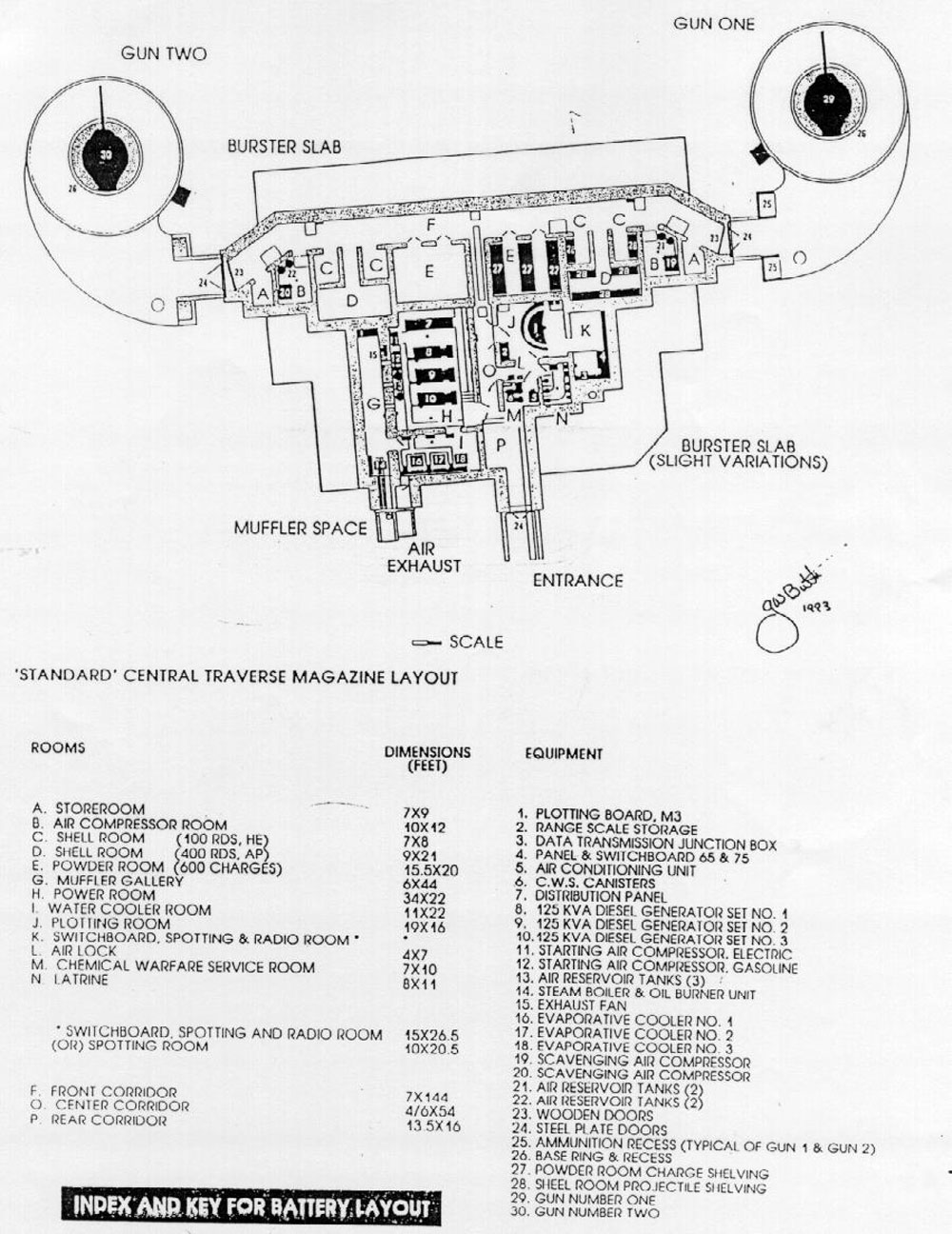Just prior to World War II and during the early 1940s five new large caliber batteries were authorized for construction at Fort MacArthur. Two were the 16-inch casemated batteries and three were the new, shielded 6-inch batteries designated as "standard" and built at various places around the U. S. and its possessions. Ninety-five of these new types of batteries were built or planned. They represented advanced technology for pointing and tracking. The 6-inch gun barrels were those taken earlier from the obsolete disappearing carriages and placed in storage. One this website, two batteries at San Francisco of this type have been described for Fort Miley, Just prior to World War II and during the early 1940s five new large caliber batteries were authorized for construction at Fort MacArthur. Two were the 16-inch casemated batteries and three were the new, shielded 6-inch batteries designated as "standard" and built at various places around the U. S. and its possessions. Ninety-five of these new types of batteries were built or planned. They represented advanced technology for pointing and tracking. The 6-inch gun barrels were those taken earlier from the obsolete disappearing carriages and placed in storage. In this book, two batteries at San Francisco of this type have been described for Fort Miley, Construction 243, and Milagra Ridge, Construction 244; and three batteries at San Diego, Battery Woodward Construction 237, Battery Humphreys, Construction 238; and Battery Grant, Construction 239.
As at the above locations, the 6-inch batteries at Fort MacArthur were almost the same design but were numbered 240, 241 and 242. The earliest of these to be constructed was Construction 241 located north of Point Fermin at what is today the Korean Friendship Bell Park.
Each battery had two 6-inch guns. Battery Construction 241 had two T2 M1 guns mounted on M4 long range Standard Barbette Carriages. These were placed under a 2-inch steel shield. Each gun could fire an armor piercing 105-pound round up to 15.4 miles.
The guns were 210 feet apart separated by the self-contained concrete magazine, plotting room, switchboard, radio, power and battery commander's station complex all buried under 6-8 feet of soil and a concrete burster shield. However, for Construction 241, the battery commander's station was behind Battery Leary-Merriam on the hill just below the Marine Exchange Building.
Construction 241 was completed in 1945 and remained in place until 1956 when it was declared surplus. The Navy used the underground rooms for radio communications during the 1960's. The Korean Friendship Bell was built on top of the battery rooms in the mid-1980s.
In 1930 the Long Point Military Reservation above Point Vincente and between Palos Verdes and Hawthorne Drives was acquired for new fire-control stations. This property was enlarged during World War II for construction of Construction 240 in 1943. There were 2 6-inch M1903A2 guns on M1 long-range barbette carriages. In 1945 this battery was named Battery Harry C. Barnes. The U.S. Coast Guard used the battery to house radar equipment after World War II.
In the 1950s and 1960s a Nike control and launch site designated LA55L&C was developed on the site. In 2004, the City of Rancho Palos Verdes' City Hall is housed in the modified buildings of the Nike administration site and uses the launch area for a maintenance yard. The author's son, Kevin, used the launch area to launch his model rockets in 1979 along with others in the local Model Rocket Club.
The 1930s era fire-control stations were located on the hillside to the east of the Nike Launch site, behind a radio-controlled model helicopter helipad in 1993. They were among the best-preserved fire control stations in the Los Angeles area.
East of the Long Point Reservation was the Sea Bench Military Reservation. This area was acquired in 1930 for the construction of new fire-control stations. A subsequent station was added in 1943. In 1993, the reserve is private property.
Work began at Bolsa Chica on March 31, 1943 on Construction 242 for a battery of 2 6-inch M T2M1 guns on M4 long-range barbette carriages. The completed battery was proof-fired on October 25, 1943. In 1945 it was named Battery Harry J. Harrison.
The Bolsa Chica Military Reservation was originally the property of a gun club. After the Army located two Panama mounts for 155-mm M1918 tractor drawn guns there in 1942, the gun club became a fancy barracks building. The Panama mounts are visible at the Marine Reserve Land on a bluff above the lagoon in 1993. The rest of the reserve is owned by the Signal Oil Company, who had plans to demolish the remains of Battery Harry J. Harrison and build condominiums in 1993.
Reference: The 6-inch gun program
is described in The Six-Inch Part of the Modernization Program
of 1940 by Robert D. Zink and Gerald W. Butler in Coast Defense
Study Group Journal, Vol. 8, No 2, May 1994, Pg 21-37
